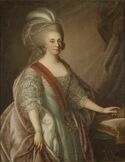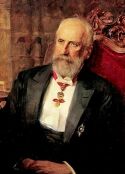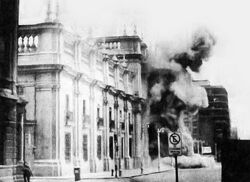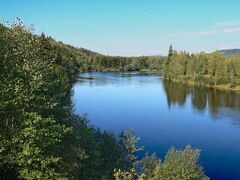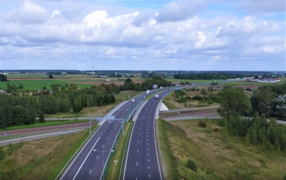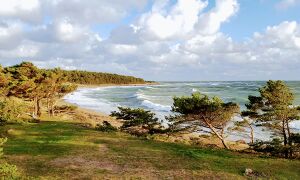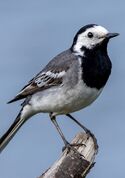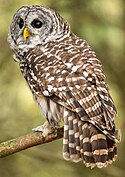Norvinia: Difference between revisions
m (word fixes) |
m (Anteria External Links) |
||
| Line 167: | Line 167: | ||
Several species of flora and fauna are considered national symbols. Hazel (Corylus), Almond (Prunus dulcis) and linden (Tilia cordata) are Norvinia's national trees and the orchid as its national flower. The white wagtail (Motacilla alba) and Barred owl (Strix varia) is Norvinia's national bird. The wildlife populations have rebounded as the hunting became more restricted and urbanization allowed replanting forests (forests already tripled in size since their lows). Currently, Norvia has approximately 250,000 larger wild animals or 5 per each square kilometre. The most prolific large wild animal in every part of the country is the roe deer, with 120,000 of them. They are followed by boars (55,000). Other ungulates are the deer (~22,000), fallow-deer (~21,000) and the largest one: moose (~7,000). | Several species of flora and fauna are considered national symbols. Hazel (Corylus), Almond (Prunus dulcis) and linden (Tilia cordata) are Norvinia's national trees and the orchid as its national flower. The white wagtail (Motacilla alba) and Barred owl (Strix varia) is Norvinia's national bird. The wildlife populations have rebounded as the hunting became more restricted and urbanization allowed replanting forests (forests already tripled in size since their lows). Currently, Norvia has approximately 250,000 larger wild animals or 5 per each square kilometre. The most prolific large wild animal in every part of the country is the roe deer, with 120,000 of them. They are followed by boars (55,000). Other ungulates are the deer (~22,000), fallow-deer (~21,000) and the largest one: moose (~7,000). | ||
==Eternal Links== | |||
{{Template:Anteria info pages}} | |||
[[Category:Anteria]] | |||
Revision as of 03:05, 14 June 2022
Unitary Republic of Norvia | |
|---|---|
| Motto: "Praevalebimus" Tis Shall Prevail | |
| Anthem: “Nation once again” | |
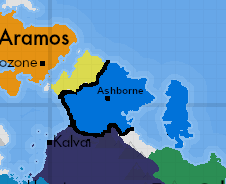 Norvia Location | |
| Capital and largest city | Ashborne |
| Recognised regional languages |
|
| Ethnic groups (c. 2022) |
|
| Religion |
|
| Demonym(s) | Norvish |
| Government | Unitary Republic |
• President | Graham Osworth |
| Legislature | The Assembly |
| Establishment | |
• Ruther Aristocracy | 11th Century |
• Grimburg Dissolution | 1330 |
• Bakyernn Hegemony | 1711 |
• Norvish Kingdom Restorement | 1827 |
• The New Republic | 1929 |
| Population | |
• 2022 census | 16.5 Million |
| GDP (nominal) | estimate |
• Total | 488 Billion ACU |
• Per capita | 29,593 ACU |
| HDI | very high |
| Currency | Roulle (℟) |
| Time zone | -3 to -4 |
| Driving side | right |
| Calling code | +12 |
| Internet TLD | .norv |
Norvia is a sovereign country located off the centre-northeast Thuadia. The Norvish Mainland is located above Greater Bakyernn State and Grimburg Island just few kilometres north of East Othinia. The country's temperate climate and large forest area, including the Calisbrooke range, owe much to Norvish natural parks & trails. The Unitary Republic includes the mainland, Grimburg territorial isles, Dunsmouth island, and many smaller outpost islands. Norvia share contigents of border with several nation, particulary Bakyernn to the south who separated by highly mountainous region, and overseas territory of Hanieflann to the north. Otherwise, Norvia located ashore east Rimidic Atlantic Ocean, is considered a developed country by giving it the one of the stable GDPs and well educated citizen. The total area by land is XXXX square km (XXX sq mi).
The country has its roots in Bakyern hegemony of the region during the 17th century. The declaration for separation war (1810) was followed by an extended period of conflict that lasted until 1837, culminating in the country's reorganization as an independent unitary state. The country thereafter enjoyed relative peace and stability, with several waves of immigration, mainly Njordrlann and Sventsan, slowly reshaping its cultural and demographic outlook; almost 60% of the population has full or partial Illanean ancestry.
The population of Norvia counted as 16.5 million (2022), with Norvish took up the majority in ethnicity. A developed country, Norvinia ranks highly in international comparisons of national performance, such as well-adjusted tax system, education, public utilities, and economic freedom. Country underwent major economic changes during the 1930s, which transformed it from a protectionist to a liberalised free-trade economy. The service sector dominates the national economy, followed by silver manufacturing and forestry.
Etymology
In Common language, the name "Norvinia/Norvia" comes from the ancient tornemmy language Nordynnea; means "(blessed) of land, by the angel". The name Norvia was first originated during aristoractic regime, given by his majesty, King Ruther Leofwine. At the time, many were confounded with the term. After several petty disagreement, the word "Norvia" is settled for the realm, though either name can be used together. The post-independent included the widely use of the name "Republic of Norvia" in civil matters. The term "Norvo" was also commonly used..
History
Origins
Thuadia is one of the first major continent settled by humans. As time goes by, radiocarbon dating, evidence of deforestation and mitochondrial DNA variability within early populations suggest that the indigenous ancestors of the native norvish were nomadic hunters of thuadian germanic group and indigenous settlers far from Pryborne to Promantia who migrated over the Norrteric sea and Klaue bay into Norvia probably during the last glacial period (11,500–30,000 years ago).
The remains of dugout boats have been found at excavations in waterlogged environments, where wood is preserved. Many of the boats have been excavated by divers at underwater settlements or found during peat-digging, these boats resembled what we now know as canoes, and most were made with the hollowed out trunk of a big tree with improvised use of logs, clay, and leaves. Large group of settlers migrated to east presumeably due to cold climate, now known as Grimburg Island, where they developed their distinct tonnermy culture.
By then the norvish region was known little until it was visited by numerous Baks and Gabriells merchants. They traded modern food, metal tools, weapons, and other goods for timber, artefacts, and water. From the late 9th century, few self-proclaimed purple blood missionaries began to proclaim the Norvia Aristocrat, eventually integrating and converting some of the population with cultural convergence and communality.
Kingdom & Aristocracy - 11th Century
In late 11th century, Ruther Leofwine, after years of unifying the people, managed to capture the large town of Ashborne, and established the Norvo Kingdom. During his long reign, Ruther provided the poorest farmers with basic medical aid, which some say led to the birth of welfare. Norvo, becoming informally known as Norvia. After securing the throne and consolidating strength, Ruther attacked the southern mountain tribe, in a show of strength. The successive battles dramatically increased the fame of the Medieval Army across the Thuadian continent, birthing a long martial tradition that remains prevalent to this day. This was Ruther's first successful conquest, expanding the Norvish realm eastwards by capturing the region of Grimburg island, and proof the new regime was worthy of the Norvish people's trust. Swiftly followed by further expansion to southern mountain range, this was truly the high point of Ruther's reign.
Norvish Kingdom continued in prosperity and advance up for more than 500 years, but that would not last long. In 1620 Rumburg declared war on Norvo to get its riches, so that the former could rebuild itself from the mess of the War of the Dying Orcids. At first, things went very badly for Norvia, with many cities being captured. Then, Eonarius succeeded his father as King, and allied himself with The Sventsan, who at the time, were also fighting against Baks. He married the Queen Lenna, starting a union that would be known as the Norvo-Sventsan Commonwealth. When Lenna died in 1703, Sventsan left the war, this of course was a huge blow to Norvia capabilities as the following years would see a decline in power. After many more years of bloody fighting, the 2 nations signed an armistice in 1710, with Bakyernn winning the war, taking over the country and sets the official claim of authority over Norvia
Colonial Peried & Separation - 1710 to 1827
Norvinia was administered as part of the Baks territory on June 1711. Civilians armed conflict began between the colonial government and Norvish with the Wrengate Affray over land and disagreements over the autonomy. These conflicts, mainly in the western Harthorne, saw thousands of imperial troops come to the region and massacred hundreds of civil populace, this became known as the Red-Water conflict. Following these armed conflicts, large amounts of southeastern Norvish was confiscated by the harsh Bakyernnian demands of no dissent policy.
In 1799, resentment towards the Baks authority over raiding and burning the city of Lorieth - the second most important cities in the province fuelled massive support for rebellion. In the decades preceding the war, Norvish became increasingly discontented with the rule. A major concern involved the forbiddance for mutual education and increased taxation imposed. The first separatist movement initially articulated by Duke Millius of Ashborne who wanted to achieve power by gathering up resistance movement across the city. This eventually developed into an overarching controversy among Baks aristocrat themselves who were against the rebels. Religious resistance, on the other hand, came with the imposition of an ecclesiastical hierarchy for all of the Baks territories. This created resistance in the eastern provinces, which had already embraced secularism.
On April 1810 under the leadership of the exiled Duke Millius, the Norvia separatist continued their resistance. They eventually were able to oust the blue-coat armies, and in 1837 they reestablished the Kingdom of Norvia with King Millius coronation. The war continued in other areas, although the heartland of the country was no longer threatened.
Post-Independence
For about a few decades later, and Norvinia would remain peaceful. An ethnic minority known as the Illaneans of Njordrlann and Sventsan territory migrated into Norvia to escape the brutal clash from the invaders. Initially, Norvish welcomed them as brothers and friends, having been persecuted with horrific efficiency by their previous rulers. The Illaneans living under Norvish rule were treated with extreme lenience by the King Millius, who gave them as much freedom as possible, granted citizenship to most all, and allowed the minority to slowly assimilate into Norvish culture. A new designation, Norvilan, was established for those who accepted Norvish citizenship. By then King Millius was put to rest and his son, Darius inherited the throne.
However, in 1875, the Bakyernnian regime embargoed and denounced the Kingdom as a result of territorial disputes between the two nations. At this time, the great Bak army was larger than all other nations' thus a significantly large navy in Norrteric sea and posed an existential threat to norvish trade. Norvia at the time was heavily dependent on sea-bound trade in Norrteric, and a naval blockade such as that imposed by the Baks was obviously catastrophic for the nation. The embargo damaged the kingdom extensively and caused further diplomatic isolation in this precarious time.
Internally, a great many issues also came to the fore, from Darius failing to birth male heirs to his continually diminishing status in the eyes of both the people and his inner circle. His only child, a young girl named Jule, was too young to rule and despised by the Royal advisors, who deemed her too young and unfit to lead. This left Darius cousin, Queen Olieanna, holder of Iverleigh Dukedom took control in 1889. The kingdom saw significant changes from social construct of mutual equality and abolished unnecessary gender limitations/requirement to hold government positions.
After Olieanna's death, King Mortimer coronated in 1913, and in just a few years he made a decision that would shape the rest of his reign: he seized all national assets, shifted them into his personal treasury, and discontinued many of the expensive welfare systems that were established before his rule. Mortimer's iron grip procedeed with heavy state surveillance and excessive authority, anyone who deemed against the state little by little will be held charges. Naturally, the move backfired and resulted in the largest protest in Norvish history. Realizing the king was not the perfect and infallible savior he had seemingly been for so long, the disgruntled people rallied behind the leader of the Republican faction in the King’s Parliament, Connor Arveton Jibrana. A liberal and national movement gained momentum after King Mortimer's authoritarian method further fuels distrusts. Nearly 5,000 suspected dissidants were arrested and 310 people were convicted of treason, this is what's known as The Friction Days.
However, paranoia and distrust among civil populace already high. In 1929, at the request of the Assembly, King Mortimer renounced his domain control over Norvinia and after intense negotiations among political figures led by advisor Connor Arveton Jibrana, who became the first president later on. They achieved its reform process by formalising the legal transition from the old monarchy unto a new republican political system, confirming that the royals could no longer legislate without the consent of Assembly. Norvinia peacefully became a republic ever since. A new constitution established a two chamber legislative systems. Nonetheless, the country still retained letting King Mortimer and his children resides in Norvinia under state provision until today.
The New Republic & Civil War
Just after King Mortimer was overthrown and Norvia was reorganized, Connor A. Jibrana was elected unanimously as the First President of the country. His administration got off to an auspicious start, as a new constitution was made, transforming the nation into a republic. Elections were scheduled for every 4 years, and implemented new open market reform with redistribution of obsolete welfare and education system.
In 1953, Bakyernnian and Norvish went head to head with border clashes, eventually triggering the War of the Broken Hills which comprises of skirmishes and mountain guerilla warfare. For the next 5 years, a 78 km-long strip of mostly unpopulated, and little explored territory, deep in the Calisbrooke mountain range and almost inaccessible by land, was the graveyard for thousands of troops from both sides; this served as a flashpoint for recurrent diplomatic and military crisis between Norvia and Bakyern. Ultimately, norvish troops weren't able to fend off the resistance and by early 1958 the treaty of morna was signed, with more than 30 to 80 square kilometres secceded to Bakyernnian territory. This was a huge blow for norvish image, especially for president Raymont who saw severe dissapointment from military generals and public alike.
With president Raymont's already weak grip over the recent events that loosened it's government image, many saw an opportunity to rebuild Norvia in their own image. Two major military leaders, Generals Oswin and Iannick, were of such an opinion. Oswin launched a coup, with goals to seize control over the Norvish government, and reigned to upheld the nationalist pride, until a government counter-coup was launched by Iannick under president's order of emergency. On May 22, 1958, tanks rolled up to schools, and soldiers pointed their guns at students. And so began the darkest time in Norvish history: the Norvish Civil War.
The height of hostilities occurred from 1962 and pitted nationalist militias against an array of groups, including the government, the Torch of Liberty party followers and ethnic minority of Norvish-Baks from southern region. In large part due to the foreign support they received, the nationalist militias were able to soundly defeat government forces and went on what has been described as a violation of human rights saw hundreds of opposition fighter executed in kangaroo court, mostly were concentrated in areas south of the country and included the murder of prominent individuals, mass killings, the burning of villages and the expulsion of the Baks population into Bakyernn. Thousand even fled into Hafnierlann and Bakyernn, it was a gloomy year.
The war ended later in December 1968, when the government forces captured the last territory held by the nationalist militia, forcing them to surrender unconditionally. The victorious government under VP Garry Maxwell, after Raymont's critical health condition prohibits further reign. Garry assumed control of the country, with rejoice from the citizen and international community. Though Garry only served as president for several years, he already contributes largely on a programme of rebuilding the infrastructure and economy of the country, bringing violent perpetrators to trial, and promoting reconciliation between each political factions. He was hailed as a hero by the people, he entered his first term with goodwill and charisma, declaring "Praevalebimus" or "We will Prevail" to the jubilant and euphoric crowds chanting his name.
Geography
Norvinia is located in the Thuadia Continent of Anteria and covers an area of XXXX km2 (XXXX sq mi). It lies between latitudes XX° and xx° N, and mostly between longitudes XX° and XX°. It has around XX kilometres (XX mi) of sandy coastline. The rest of the coast is sheltered by the Curonian sand peninsula. Norvinia's major warm-water port, Pearla, lies at the narrow mouth of the Raindale Lagoon, a shallow lagoon extending east to Grimburg strait. The country's main and largest river, the Eugena River, and some of its tributaries carry international shipping.
Norvia lies at the edge of the Northeast Thuadian Forest Region. Its landscape was smoothed by the glaciers of the last ice age, and is a combination of moderate lowlands and highlands. Its highest point is Point Aleymont Hill at 1,300 metres in the southern part of the country. Lympton is the largest, Gyrra is the deepest and Villana is the longest lake in Norvia.
Climate
Norvia has a temperate climate that has been described in various sources as either humid continental or oceanic/maritime. Coastal regions, especially Grimburg island and the western coast of the Iverleigh State , possess a more maritime climate with cooler summers and milder winters, while eastern parts exhibit a more continental climate with warmer summers and harsher winters.
The country has four pronounced seasons of near-equal length. Winter starts in mid-December and lasts until mid-March. Winters have average temperatures of −6 °C (21 °F) and are characterized by stable snow cover, bright sunshine, and short days. Severe spells of winter weather with cold winds, extreme temperatures of around −30 °C (−22 °F) and heavy snowfalls are common. Summer starts in June and lasts until August. Summers are usually warm and sunny, with cool evenings and nights. Summers have average temperatures of around 19 °C (66 °F), with extremes of 35 °C (95 °F). Spring and autumn bring fairly mild weather. Severe storms are rare in the western part of Norvia but common in the coastal areas.
Environment
Most of the country is composed of fertile lowland plains and moderate hills. In a typical Norvish landscape, a mosaic of vast forests alternates with fields, farmsteads, and pastures. Arable land is spotted with birch groves and wooded clusters, which afford a habitat for numerous plants and animals. Norvia has hundreds of kilometres of undeveloped seashore—lined by pine forests, dunes, and continuous white sand beaches. Country is one of the highest proportion of land covered by forests in the Thuadia, and Anteria with the forests account for 53% of the total land area.
Forest has long been one of the most important natural resources in Norvinia. Forests occupy almost half of the country's territory and timber-related industrial production accounts for almost 25% industrial production in the country. Norvinia has 8 national parks, 50 regional parks, 402 nature reserves, 368 state-protected natural heritage objects.
- Landscapes of Norvinia
Eugena River, Harthorne State
Highway Plains near Ashborne
Eastern coast, Iverleigh State
Biodiversity
There is a very good level of knowledge about the biodiversity of Norvia. It is estimated that the number of species in the country totals around 43,000, of which 18,000 species are plants and fungi and 25,000 animals (of which around 700 species are vertebrates). There are 485 communities of plants (using the Braun-Blanquet method), which characterizes the entire biodiversity of land, freshwater and marine communities. Around 12 % of them are endemic communities. Several nature reserves protect unspoiled landscapes with a variety of large animals. At many Nature Reserve, where bison, wild horses, and recreated aurochs have been reintroduced, there is now an almost complete Holocene megafauna also including moose, deer, and wolves.
Norvinia is characterised by a rich mosaic of habitats which are the result of massive untouched forest region, particularly in western areas. A considerable portion of agricultural areas has high natural value, providing refuge for threatened flora and fauna. Thanks to small scale agriculture, Norvia has retained to this day local crop varieties and traditional breeds. Nature in Norvia has been negatively affected by human development at varying levels within the country: unevenly spread mining industrialisation and urbanisation coexist with large areas characterised by agriculture and extensive ancient forests
Several species of flora and fauna are considered national symbols. Hazel (Corylus), Almond (Prunus dulcis) and linden (Tilia cordata) are Norvinia's national trees and the orchid as its national flower. The white wagtail (Motacilla alba) and Barred owl (Strix varia) is Norvinia's national bird. The wildlife populations have rebounded as the hunting became more restricted and urbanization allowed replanting forests (forests already tripled in size since their lows). Currently, Norvia has approximately 250,000 larger wild animals or 5 per each square kilometre. The most prolific large wild animal in every part of the country is the roe deer, with 120,000 of them. They are followed by boars (55,000). Other ungulates are the deer (~22,000), fallow-deer (~21,000) and the largest one: moose (~7,000).
Eternal Links




